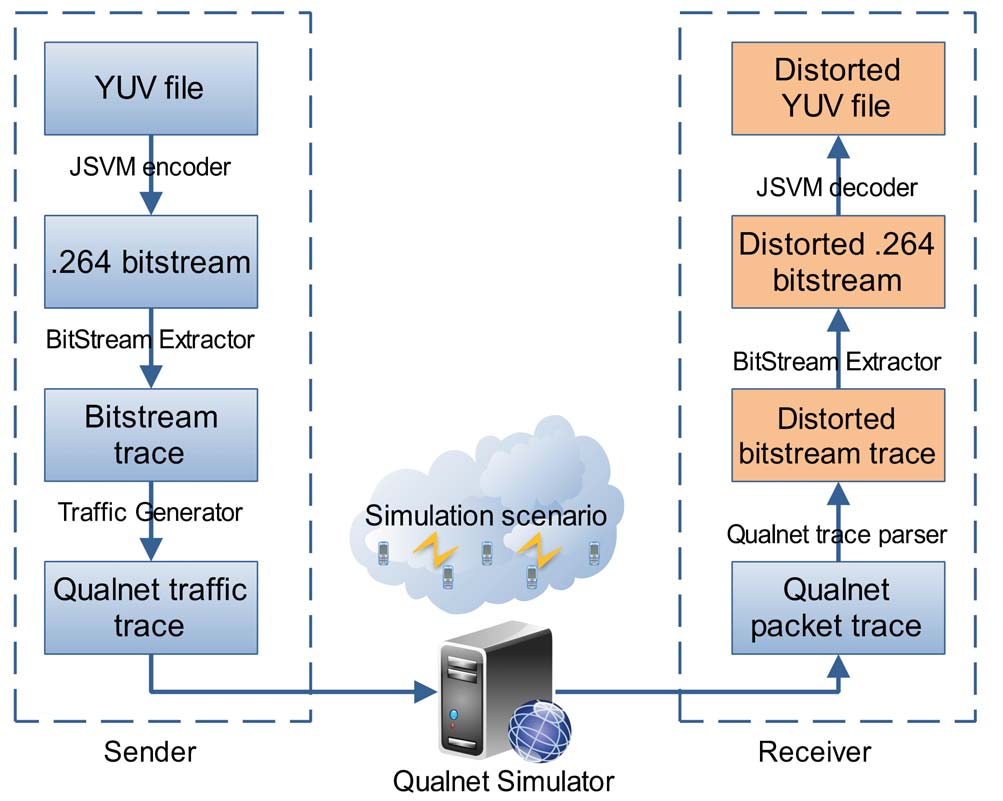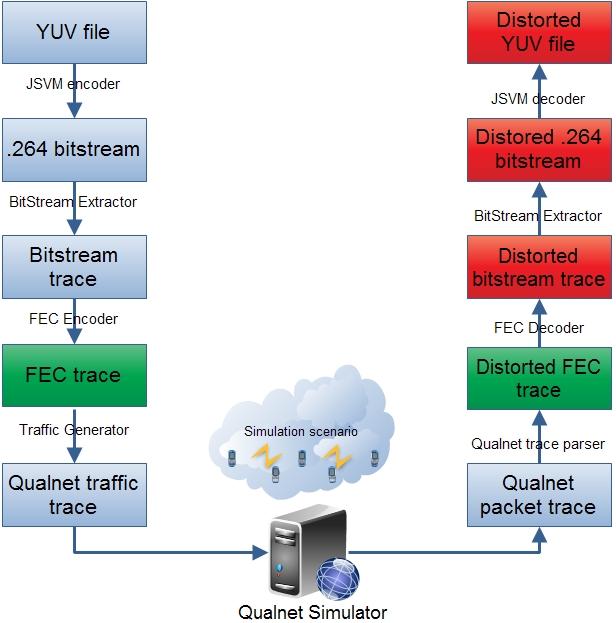SVCEval
To evaluate the H.264/SVC transmission over different kinds of networks, especially ad hoc networks, we proposed a evaluation framework SVCEval . It is based on the SVC reference software JSVM and make use of the Qualnet simulator for the network simulation.
The SVCEval is written in Java. An introduction of the framework is available at P156 9.1.2 SVCEval Evaluation Framework of MP-OLSR_thesis.pdf. The details of parameters for QualnetTraceParser is at P183 Appendix D of MP-OLSR_thesis.pdf.
NOTE:
- A sample of the configuration is presented in P161 of MP-OLSR_thesis.pdf. Please pay attention to the parameter SliceMode and SliceArgument, which defines the size of the packet.
- In the bitstream trace, there are some 9-byte packets that are commonly not useful for the decoding. So it’s better to remove those packets during the video transmission simulation. Check P150 Section 8.2.2 Packet priority in H.264/SVC of MP-OLSR_thesis.pdf for more info.
- In the current simulation, an old version of JSVM (9.8) is used. This is at the moment, the error concealment function are removed in the new version. If the user wants to use the latest version, please make sure that the error concealment function are included.
- In JSVM 9.8, there are still some bugs exist. So for the last several frames of the decoding, there are probably some errors occur. Just ignore them.
Source code is available at
SVCEval_FECSim
or on GitHub https://github.com/yijiazi/SVCEval

At the video sender, the YUV file is encoded by the JSVM encoder, and the .264 bitstream is generated. Then the BitStreamExtractor is used to generate the bitstream trace from the given bitstream. It is a text file which specifies the parameters of each packet inside the bitstream. Those parameters include the start position of the packet inside the bitstream, the length of the packets, the values of dependency id (LId), temporal level (TId) and quality level (QId) for the packet, the type of the packet and two flag which indicate whether the packet is discardable or truncatable. A Traffic Generator is written to generate the input traffic trace file for Qualnet simulation, which includes mainly the packet rate and size. The simulator will take the traffic trace file and run the simulation according the configuration of scenarios to simulate different kinds of networks.
At the video receiver, a packet trace file is produced by the simulator. The packet trace file records all the operation on each packet in each node and each layer (so normally hundreds of MBytes). A QualnetTraceParser is developed to analyse the trace to detect which packets are lost and which packets are properly received. For real-time transmission, we can set a delay threshold to discard the packets that timed out. The trace parser can generate the distorted bitstream trace, and then we use the BitstreamExtractor and JSVM decoder to have the distorted YUV file after the video transmission. Then we can evaluate the quality of video with different metrics such as PSNR or Mean Opinion Score (MOS).
FECSim
FECSim is an FEC codec simulator to analysis the performance of the Unequal Error Protection of FEC coding in H.264/SVC network transmission.
An introduction of the FECSim can be found at P160 of MP-OLSR_thesis.pdf . A short manual is at P185, Appendix E of MP-OLSR_thesis.pdf.

It mainly consists of two parts: in the sender, the QualnetFECTrafficGen plays as a FEC encoder; in the receiver, the QualnetFECTraceParser plays as a FEC decoder.
QualnetFECTrafficGen
The FEC traffic generator simulates the behavior of FEC encoder. It reads the original bitstream packet trace and the configuration of the priority FEC:
t1 2 3 2 s
t2 2 3 2 s
The configuration means that for temporal layer t1 and t2 , the encoder will buffer 2 data packets, and generate 3 coded projections with the same size. In the receiver, 2 projections in 3 are needed to recover the original packets. The s means that systematic code is used.
QualnetFECTraceParser
The FEC trace parser simulates the behavior of FEC decoder. It reads the Qualnet packet trace and generates the distorted bitstream trace based on the FEC trace (generated by QualnetFECTrafficGen ).
Related publications
2012
Radu, Dan; Avram, Camelia; Aştilean, Adina; Parrein, Benoît; Yi, Jiazi
Acoustic noise pollution monitoring in an urban environment using a VANET network Proceedings Article
In: 2012 IEEE International Conference on Automation Quality and Testing Robotics (AQTR), pp. 244-248, IEEE, Cluj-Napoca, 2012, ISBN: 978-1-4673-0701-7.
@inproceedings{yi-vanet-2011,
title = {Acoustic noise pollution monitoring in an urban environment using a VANET network},
author = {Dan Radu and Camelia Avram and Adina Aştilean and Benoît Parrein and Jiazi Yi},
url = {http://jiaziyi.com/wp-content/uploads/2016/08/Acoustic-noise-pollution-monitoring-in-an-urban-environment-using-a-VANET-network.pdf
http://ieeexplore.ieee.org/xpl/articleDetails.jsp?arnumber=6237711
},
doi = {10.1109/AQTR.2012.6237711},
isbn = {978-1-4673-0701-7},
year = {2012},
date = {2012-05-24},
booktitle = {2012 IEEE International Conference on Automation Quality and Testing Robotics (AQTR)},
pages = {244-248},
publisher = {IEEE},
address = {Cluj-Napoca},
abstract = {The main objective of this work is the development of a Vehicle Ad Hoc NETwork (VANET) to collect data from GPS equipped mobile phones used as noise detectors. In this system, sensor nodes perioadically transmit acoustic noise levels to neighboring cars, data packets being shared and temporary stored by participating VANET nodes and ultimately forwarded to a collector node connected to the Internet, providing public real-time data. A routing technique called MP-OLSR that takes into account the spatially separation between the multiple paths is used, for better transmission reliability and congestion avoidance as well as for control message overhead minimization.},
keywords = {},
pubstate = {published},
tppubtype = {inproceedings}
}
The main objective of this work is the development of a Vehicle Ad Hoc NETwork (VANET) to collect data from GPS equipped mobile phones used as noise detectors. In this system, sensor nodes perioadically transmit acoustic noise levels to neighboring cars, data packets being shared and temporary stored by participating VANET nodes and ultimately forwarded to a collector node connected to the Internet, providing public real-time data. A routing technique called MP-OLSR that takes into account the spatially separation between the multiple paths is used, for better transmission reliability and congestion avoidance as well as for control message overhead minimization.
Radu, Dan; Yi, Jiazi; Parrein, Benoit
QoE enhancement for H.264/SVC video transmission in MANET using MP-OLSR protocol Proceedings Article
In: ISIVC 2012, the 6th International Symposium on signal, Image, Video and Communications, pp. 1-4, Valenciennes, France, 2012.
@inproceedings{radu:hal-00716057,
title = {QoE enhancement for H.264/SVC video transmission in MANET using MP-OLSR protocol},
author = {Dan Radu and Jiazi Yi and Benoit Parrein},
url = {http://jiaziyi.com/wp-content/uploads/2016/08/QoE-enhancement-for-H.264SVC-video-transmission-in-MANET-using-MP-OLSR-protocol-.pdf
https://hal.archives-ouvertes.fr/hal-00716057},
year = {2012},
date = {2012-01-01},
booktitle = {ISIVC 2012, the 6th International Symposium on signal, Image, Video and Communications},
pages = {1-4},
address = {Valenciennes, France},
abstract = {This paper addresses the problem of enhancing video service quality for Mobile Ad Hoc Networks (MANET) scenarios. We offer Multipath Optimized Link State (MP-OLSR) routing protocol for H.264/SVC bitstream forwarding in the MANET network. Besides the usage of a suitable routing protocol, the video quality can be further enhanced by using the scalable encoding feature of Scalable Video Coding (SVC) combined with Unequal Error Protection (UEP). SVC is an extension of the H.264/AVC video compression standard used for high-quality video bitstreams encoding, providing spatial, temporal and quality scalability. To evaluate video quality, the Video Quality Metric (VQM) is used. We chose 5 different video contents for our simulations characterized by various temporal and spatial complexities. These video references are taken from the Video Quality Expert Group (VQEG). The results show that multipath routing combined with UEP can effectively improve the quality of video communication over MANET in terms of VQM and successful video decoding.},
keywords = {},
pubstate = {published},
tppubtype = {inproceedings}
}
This paper addresses the problem of enhancing video service quality for Mobile Ad Hoc Networks (MANET) scenarios. We offer Multipath Optimized Link State (MP-OLSR) routing protocol for H.264/SVC bitstream forwarding in the MANET network. Besides the usage of a suitable routing protocol, the video quality can be further enhanced by using the scalable encoding feature of Scalable Video Coding (SVC) combined with Unequal Error Protection (UEP). SVC is an extension of the H.264/AVC video compression standard used for high-quality video bitstreams encoding, providing spatial, temporal and quality scalability. To evaluate video quality, the Video Quality Metric (VQM) is used. We chose 5 different video contents for our simulations characterized by various temporal and spatial complexities. These video references are taken from the Video Quality Expert Group (VQEG). The results show that multipath routing combined with UEP can effectively improve the quality of video communication over MANET in terms of VQM and successful video decoding.
2011
Yi, Jiazi; Parrein, Benoit; Radu, Dan
Multipath routing protocol for manet: Application to H.264/SVC video content delivery Proceedings Article
In: Wireless Personal Multimedia Communications (WPMC), 2011 14th International Symposium on, 2011, ISBN: 1347-6890.
@inproceedings{yi-svc-2011,
title = {Multipath routing protocol for manet: Application to H.264/SVC video content delivery},
author = {Jiazi Yi and Benoit Parrein and Dan Radu},
url = {http://jiaziyi.com/wp-content/uploads/2016/08/MP-OLSR-SVC_WPMC2011_v0.1.pdf
http://ieeexplore.ieee.org/xpl/articleDetails.jsp?arnumber=6081479},
isbn = {1347-6890},
year = {2011},
date = {2011-10-03},
booktitle = {Wireless Personal Multimedia Communications (WPMC), 2011 14th International Symposium on},
abstract = {Multi-Path OLSR is an extension of the single path routing protocol OLSR. The QoS has been demonstrated in simulation and testbed. In this paper, we attempt to confirm those results at the application layer specially for critical applications as video services over wireless networks. The standard H264/SVC is chosen for its enormous potential in video delivery in lossy networks. Still vulnerable to packet losses, we combine the scalable source coding to an Unequal Error Protection (UEP) scheme in order to improve a simple Quality of Experience (QoE) measurements i.e PSNR. In a new simulation framework called SVCEval, the combination of path diversity and scalable protection insures a significant 2 dB gain in QoE for sensitive contents and mobile scenarios in comparison with just MP-OLSR. Within the same context, single path strategy delivers non acceptable video services as soon as nodes are mobile.
},
keywords = {},
pubstate = {published},
tppubtype = {inproceedings}
}
Multi-Path OLSR is an extension of the single path routing protocol OLSR. The QoS has been demonstrated in simulation and testbed. In this paper, we attempt to confirm those results at the application layer specially for critical applications as video services over wireless networks. The standard H264/SVC is chosen for its enormous potential in video delivery in lossy networks. Still vulnerable to packet losses, we combine the scalable source coding to an Unequal Error Protection (UEP) scheme in order to improve a simple Quality of Experience (QoE) measurements i.e PSNR. In a new simulation framework called SVCEval, the combination of path diversity and scalable protection insures a significant 2 dB gain in QoE for sensitive contents and mobile scenarios in comparison with just MP-OLSR. Within the same context, single path strategy delivers non acceptable video services as soon as nodes are mobile.


